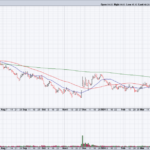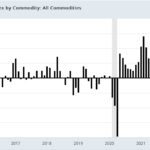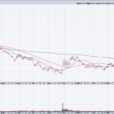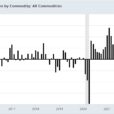
 Image source: PixabayWhen monetary policy decisions by the Federal Reserve are discussed, some commentators believe that the Fed won’t cut interest rates just before an election. Others have said in past cycles that the Fed won’t raise rates before an election. In reality, the Fed has done both in the past, and we should ignore the election when trying to forecast what they will do.The chart suggests that in most cases, changes in the interest rates are pretty small. The two exceptions are noteworthy. The blue line at the top of the chart shows 1980, when Paul Volcker raised interest rates to fight inflation. The next line down shows 1984, when the Fed cut rates as the economy recovered from the 1982 recession.Looking at numbers rather than charts, I calculated changes in the Fed’s policy rate, called the Federal Funds Rate, for the six months leading up to November in every year since the data began, 1955. Presidential election years averaged increases of 0.18 percentage points, while non-election years averaged declines of 0.01 percentage points. The average change, ignoring direction, was 0.92 percentage points, so the difference between election years and non-election years is trivial. (For statistics buffs, the standard deviation of the six-month changes for all periods is 1.47 percentage points, making the average of elections years not significantly different from non-election years.)The current Fed may well act differently than past Feds. The members of the policy-making group, the Federal Open Market Committee, change over time. In addition, five of the 12 presidents of the regional Federal Reserve Banks vote, with voting rights rotating among the regions (except that the New York Fed president always votes).The seven members of the Federal Reserve Board serve for 14-year terms, insulating them from much political pressure. The chair serves a four-year term as chair; if not reappointed, he or she can continue to fill the term as a member, though usually that doesn’t happen. And the chair’s term starts a year after the presidential inauguration, further insolating the chair. The presidents of the regional banks are appointed by their boards of directors, consisting of both local bankers and members of the public.Clinging to a job may be imagined, but pretty much everyone on the FOMC can make more money in the private sector. Federal Reserve Board salaries range from $222,000 to $246,000 a year. Presidents of the regional banks typically earn more, varying from bank to bank, but generally much less than the CEOs of private sector banks.The Federal Reserve will likely begin cutting interest rates in the summer of 2024. Federal Reserve chair Jerome Powell has stated multiple times that policy would be “data dependent,” meaning that they have not yet selected a particular path forward, but would make decisions as they get more information. Based on the mostly likely path for inflation and the overall economy, and the Fed’s vision of how the economy works, two or three small drops in the Federal Funds rate are likely this year, the election not withstanding.More By This Author:AI Implementation In Business: Lessons From Diverse IndustriesFood Costs Are High: The Diet Of Misleading InformationConsumers Will Keep On Spending In 2024
Image source: PixabayWhen monetary policy decisions by the Federal Reserve are discussed, some commentators believe that the Fed won’t cut interest rates just before an election. Others have said in past cycles that the Fed won’t raise rates before an election. In reality, the Fed has done both in the past, and we should ignore the election when trying to forecast what they will do.The chart suggests that in most cases, changes in the interest rates are pretty small. The two exceptions are noteworthy. The blue line at the top of the chart shows 1980, when Paul Volcker raised interest rates to fight inflation. The next line down shows 1984, when the Fed cut rates as the economy recovered from the 1982 recession.Looking at numbers rather than charts, I calculated changes in the Fed’s policy rate, called the Federal Funds Rate, for the six months leading up to November in every year since the data began, 1955. Presidential election years averaged increases of 0.18 percentage points, while non-election years averaged declines of 0.01 percentage points. The average change, ignoring direction, was 0.92 percentage points, so the difference between election years and non-election years is trivial. (For statistics buffs, the standard deviation of the six-month changes for all periods is 1.47 percentage points, making the average of elections years not significantly different from non-election years.)The current Fed may well act differently than past Feds. The members of the policy-making group, the Federal Open Market Committee, change over time. In addition, five of the 12 presidents of the regional Federal Reserve Banks vote, with voting rights rotating among the regions (except that the New York Fed president always votes).The seven members of the Federal Reserve Board serve for 14-year terms, insulating them from much political pressure. The chair serves a four-year term as chair; if not reappointed, he or she can continue to fill the term as a member, though usually that doesn’t happen. And the chair’s term starts a year after the presidential inauguration, further insolating the chair. The presidents of the regional banks are appointed by their boards of directors, consisting of both local bankers and members of the public.Clinging to a job may be imagined, but pretty much everyone on the FOMC can make more money in the private sector. Federal Reserve Board salaries range from $222,000 to $246,000 a year. Presidents of the regional banks typically earn more, varying from bank to bank, but generally much less than the CEOs of private sector banks.The Federal Reserve will likely begin cutting interest rates in the summer of 2024. Federal Reserve chair Jerome Powell has stated multiple times that policy would be “data dependent,” meaning that they have not yet selected a particular path forward, but would make decisions as they get more information. Based on the mostly likely path for inflation and the overall economy, and the Fed’s vision of how the economy works, two or three small drops in the Federal Funds rate are likely this year, the election not withstanding.More By This Author:AI Implementation In Business: Lessons From Diverse IndustriesFood Costs Are High: The Diet Of Misleading InformationConsumers Will Keep On Spending In 2024
















